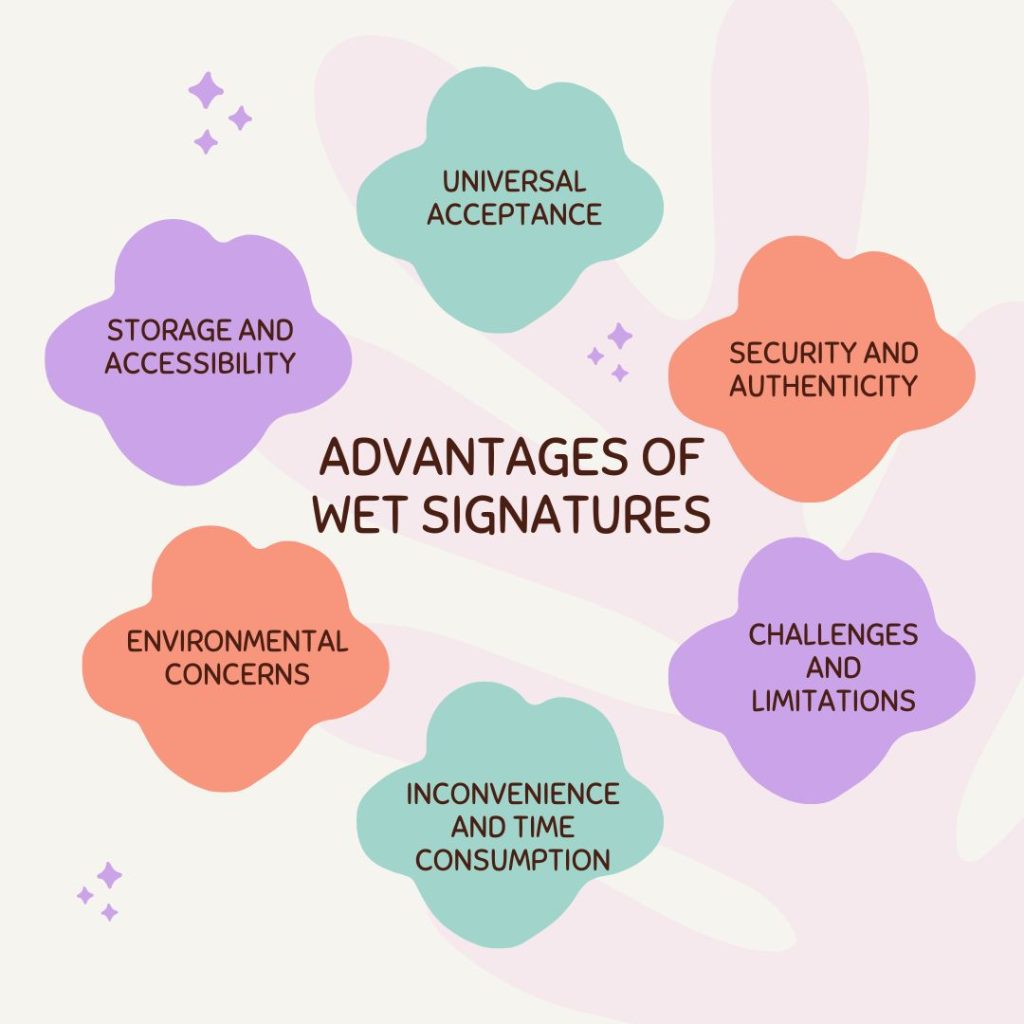In this rapidly evolving digital era, where the click of a button can seal a deal or dispatch an agreement across continents in seconds, the notion of a ‘wet signature‘ might appear to be a relic of a bygone era. Yet, despite the surge in digital transactions, the traditional act of signing a document with pen and ink – what we refer to as a ‘wet signature’ – retains a profound legal and symbolic stature that cannot be overlooked. In various legal, business, and personal contexts, a wet signature is more than just a formality; it is a robust testament to the authenticity and personal commitment of the signatory.
This article aims to provide a comprehensive understanding of the wet signature in the context of our modern, digital-first world. We’ll explore the essence of wet signatures, delineate their critical legal ramifications, and draw a comparison with their electronic counterparts. Furthermore, we delve into why, despite the convenience and efficiency of digital methods, wet signatures continue to play a pivotal role in many official, legal, and significant personal transactions.
The exploration is not just a dive into legal formalities but an insight into the enduring value of personal touch in our increasingly impersonal digital world. By understanding the continued relevance of wet signatures, we gain a better appreciation of how traditional practices can coexist with and complement modern technological advancements, thereby enriching our approach to legal and personal authenticity in the digital age.
What is a Wet Signature?
A wet signature is the physical manifestation of a person’s agreement and intent, captured through the act of marking a document with their signature using a pen and ink. This signature, referred to as ‘wet’, earns its name from the fact that the ink is freshly applied and wet at the moment of signing, although it quickly dries. This form of signature, rooted in tradition, has stood the test of time as a fundamental element in validating and authenticating documents for centuries. It goes beyond a mere scribble on paper; it is a tangible, personal mark that symbolizes agreement and identity.
In a world that increasingly leans towards digitization, the wet signature maintains a revered status in the annals of legal and official documentation. Its continued usage spans a myriad of important documents – from legal contracts and agreements to personal documents like wills and trusts. It’s this personal, tangible nature of the wet signature that lends it a sense of solemnity and gravity, making the act of signing a thoughtful and deliberate decision.
Legal Standing of Wet Signatures
Globally, legal systems recognize the wet signature not just as a formality, but as a robust declaration of a person’s conscious agreement and acknowledgment of the contents of a document. In the eyes of the law, it is more than a symbol; it is evidence of a person’s deliberate intention to be bound by the terms and conditions laid out in a document. The unique form of each individual’s wet signature further enhances its legal standing, as it is difficult to replicate, thus providing a layer of security and assurance of authenticity.
The enduring relevance of wet signatures in legal contexts underscores their importance as a bridge between physical authenticity and legal accountability. They embody a sense of personal presence and commitment, attributes that digital signatures, despite their convenience and efficiency, have yet to fully replicate. In contracts, agreements, and critical legal documents, the wet signature continues to hold a position of paramount importance, serving as a timeless testament to individual intent and agreement.
Wet Signatures in the Digital Age
In an era where digital technology is ubiquitous, reshaping how we communicate, work, and conduct business, the relevance of traditional wet signatures might seem to be waning. This shift prompts an important question: in a world increasingly reliant on digital processes, do wet signatures still hold their ground? The answer, as one might expect in our multifaceted legal and personal landscapes, is not straightforward. It varies considerably based on a variety of factors, including legal stipulations, the specific nature of the documents in question, and individual or organizational preferences.
The Growing Dominance of Electronic Signatures
In recent years, the transition to electronic signatures has been accelerated by their unparalleled convenience and efficiency. This form of signature involves the digital signing of documents, eliminating the need for physical presence and the logistical challenges of paper-based processes. The legal recognition of electronic signatures in numerous jurisdictions has been a significant factor in their widespread adoption. For instance, in the United States, the Electronic Signatures in Global and National Commerce Act (ESIGN) provides a legal framework for their use. Similarly, in the European Union, the Electronic Identification, Authentication and Trust Services (eIDAS) regulation has standardized electronic signatures, lending them legal weight across member states.
This legal backing has not only boosted the confidence of individuals and organizations in using electronic signatures but has also catalyzed the growth of industries and services that rely on remote verification and digital processes. From signing a mortgage application online to closing multi-million-dollar business deals, electronic signatures are becoming a common feature in our daily transactions.
The Continued Importance of Wet Signatures
However, this does not imply that wet signatures have become obsolete. In various scenarios, especially those involving high-stakes agreements or highly sensitive documents, the physical act of signing with ink continues to hold significant value. Wet signatures are often deemed essential for certain legal documents, including wills, deeds, and certain corporate agreements, where the traditional signature is considered a key element of the authenticity and solemnity of the agreement. Additionally, some jurisdictions and sectors still mandate wet signatures due to either slow adoption of digital alternatives or because of entrenched legal and regulatory frameworks.
Moreover, for many individuals and organizations, the use of wet signatures is a matter of personal preference and comfort. The tactile act of signing a document can imbue a sense of certainty and solemnity, reinforcing the gravity of the commitment being made. This psychological aspect, coupled with the legal recognition and tradition of wet signatures, ensures their continued relevance in various contexts.
In conclusion, while the digital age has certainly ushered in a paradigm shift towards electronic signatures, wet signatures maintain their significance in specific legal, personal, and business realms. The future likely holds a hybrid model, where both forms of signatures coexist and are used as per the demands of the situation, legal requirements, and personal choices. This complementary relationship between the old and the new epitomizes the adaptability and diversity of our evolving digital world.
Comparing Wet and Electronic Signatures
The evolution of signature methods, from the traditional wet signature to the modern electronic signature, marks a significant shift in how we validate documents and agreements. Understanding the differences between these two types of signatures is key in determining their appropriate use in various contexts.
Method of Execution
The primary distinction lies in their execution. Wet signatures necessitate the physical presence of the signatory, who uses a pen to leave their mark on a physical document. This method, rooted in tradition, has been the standard for centuries. On the other hand, electronic signatures offer a more modern approach, harnessing digital technology to authenticate documents. These can be executed remotely using a range of technologies, from digital pens and finger signatures on touch screens to secure online platforms that verify the signer’s identity and intent.
Despite the modern convenience offered by electronic signatures, there are situations where a wet signature is still the preferred, or even legally required, method. For instance, certain legal documents, such as wills, affidavits, real estate deeds, and specific corporate agreements, often necessitate a wet signature for legal validity. This requirement reflects both legal tradition and the nature of the transactions involved.
Advantages of Wet Signatures
Wet signatures maintain their relevance and advantages in certain contexts, despite the digital era’s advances. One significant aspect is their psychological impact. The physical act of signing a document with pen and ink can impart a sense of gravity and solemnity. This ceremonial aspect of signing can be crucial in significant personal or business transactions, where the act of physically signing a document signifies a deeper level of engagement and commitment. The tangible nature of a wet signature, with the unique characteristics of each individual’s handwriting and signature style, adds a personal touch that electronic signatures cannot replicate. This can be particularly important in high-stakes agreements or in contexts where personal trust and responsibility are emphasized.
Additionally, wet signatures, being the traditional standard, are universally recognized and understood. They do not require any technological interface, making them accessible to everyone, regardless of technological proficiency or access. In legal terms, they have a long-standing history of acceptance and enforceability, which gives them a degree of reliability and security in legal processes.
In summary, while electronic signatures offer convenience and efficiency, especially in a world that increasingly operates remotely and digitally, wet signatures continue to hold significant value in various situations. They provide a sense of authenticity, solemnity, and personal commitment that remains crucial in many legal and personal contexts. Understanding when and how to use each type of signature is vital in navigating the legal and procedural landscapes of both the physical and digital worlds.

Universal Acceptance
One of the most significant advantages of wet signatures is their universal acceptance and understanding. Across cultures and legal systems, the act of physically signing a document has been a long-established norm, carrying a weight of authenticity and commitment that is recognized worldwide. This universal acceptance becomes particularly crucial in international transactions, where legal frameworks and technological advancements may vary greatly between regions. In such scenarios, relying on wet signatures eliminates the complexities and uncertainties associated with electronic signature laws that might differ from one country to another.
Security and Authenticity
The security and authenticity offered by wet signatures are unparalleled. Each wet signature is unique to the individual who created it, capturing the nuances of their handwriting and style. This uniqueness makes wet signatures inherently difficult to replicate or forge, especially electronically. Furthermore, wet signatures do not rely on digital security measures, which, despite advancements in cybersecurity, can still be vulnerable to hacking, fraud, and technical failures. This independence from digital platforms ensures that the integrity of a wet signature remains intact, free from the risks associated with digital data breaches or technological malfunctions.
Challenges and Limitations
Despite these advantages, the use of wet signatures is not without its challenges, particularly in an increasingly digital world. The most apparent challenge is the logistical aspect of obtaining a wet signature. In an age where businesses and personal interactions often occur remotely, requiring a physical signature can be impractical and time-consuming. This can slow down processes, hinder efficiency, and potentially lead to delays in critical transactions.
Another limitation is the environmental impact. The need for physical documentation in the use of wet signatures contributes to paper consumption, which, in turn, has ecological implications. The storage of paper documents also presents challenges. Unlike digital files, which can be stored and organized efficiently in vast quantities, physical documents require physical space, are prone to wear and tear, and can be more challenging to retrieve and organize effectively.
In addition to these logistical and environmental concerns, there is also the aspect of scalability. As businesses grow and their operations expand, managing an increasing volume of wet-signed documents can become cumbersome and resource-intensive. This is particularly true for businesses that operate across multiple geographical locations, where the coordination of physical documents can become a complex and costly endeavor.
In conclusion, while wet signatures offer significant advantages in terms of universality, security, and authenticity, they also present challenges in terms of logistics, environmental impact, and scalability in a digital-centric world. Recognizing these challenges is essential for individuals and organizations when deciding the most appropriate and efficient method of authentication for their specific needs.
Inconvenience and Time Consumption
In our fast-paced world, where efficiency and speed are often of the essence, the traditional wet signature can pose significant inconveniences and time constraints. The most evident drawback is the requirement for physical presence. For a document to be wet-signed, all parties involved must be in the same location or wait for the document to be transported from one place to another. This can be particularly challenging in situations that demand quick decision-making or when parties are geographically dispersed. In cases where immediate or remote authorization is required, the logistics of obtaining a wet signature can cause frustrating delays, potentially impeding business transactions, slowing down legal processes, or delaying critical decisions.
Environmental Concerns
Another concern associated with wet signatures is their environmental impact. This form of signature necessitates the use of paper, and in a world increasingly aware of ecological footprints, the paper-based nature of wet signatures is becoming more of a liability. Each paper document signed and stored contributes to the growing problem of paper waste. Moreover, the transportation of these documents, whether by mail or courier services, adds to the carbon footprint, especially for international transactions. As businesses and individuals become more environmentally conscious, the push towards more sustainable, paperless solutions is intensifying.
Storage and Accessibility
Wet-signed documents also pose challenges in terms of storage and accessibility. Physical documents require space and appropriate conditions for storage to prevent damage or loss. Over time, paper can deteriorate, ink can fade, and the risk of physical damage from environmental factors increases. Furthermore, organizing and retrieving physical documents can be far more cumbersome than managing digital files. In contrast, digital storage allows for efficient organization, quick searchability, and better accessibility, making the management of large volumes of documents simpler and more streamlined.
This juxtaposition of the traditional, tangible nature of wet signatures against the backdrop of digital efficiency highlights a critical decision point for businesses and individuals alike. While the authenticity and solemnity of a wet signature are undeniable, the practical limitations of time consumption, environmental impact, and storage challenges are increasingly pushing the modern world towards digital solutions. Acknowledging and adapting to these challenges is crucial for those who continue to rely on wet signatures as part of their operational or legal processes.
Balancing Wet and Electronic Signatures
In our rapidly digitalizing world, the decision to use wet or electronic signatures is increasingly becoming a balancing act, one that hinges on various factors including convenience, legal requirements, the nature of the transaction, and personal or organizational preferences.
Legal Requirements
Understanding and adhering to the legal frameworks governing signatures is paramount. While electronic signatures have gained widespread legal acceptance and are valid for most transactions, there are still instances where law mandates a wet signature. For example, certain legal declarations, deeds, and official government documents may explicitly require a traditional wet signature due to their longstanding legal precedent and perceived higher level of authenticity. It is essential for individuals and organizations to be cognizant of these legal distinctions to ensure the validity and enforceability of their documents.
Nature of Transactions
The type of transaction often dictates the most appropriate form of signature. High-value agreements or documents of significant personal importance might necessitate the solemnity and deliberate action of a wet signature. On the other hand, electronic signatures offer unmatched efficiency and are thus ideal for routine or high-volume transactions, such as standard business contracts or online agreements. This efficiency is particularly pertinent in today’s fast-paced business environment, where speed can be a critical factor.
The Future of Wet Signatures
Despite the digital shift, the future of wet signatures seems secure, primarily due to their deep-rooted legal and psychological impact. Moving forward, it is likely that wet signatures will continue to coexist alongside electronic signatures, each serving distinct needs based on the context.
Technological Integrations
Technological advancements are bridging the gap between the authenticity of wet signatures and the convenience of digital processes. Innovative solutions are emerging where wet signatures are digitally captured and securely integrated into electronic documents. This hybrid approach retains the personal touch of a wet signature while leveraging the efficiency of digital storage and transmission.
Legal Evolutions
As legal frameworks evolve to keep pace with technological advancements, we may see an expansion in the types of documents that can accept electronic signatures. However, the enduring importance of wet signatures in certain legal and ceremonial contexts suggests that they are unlikely to become entirely obsolete. Instead, they will likely adapt, finding new roles and applications in a digital landscape.
In summary, the choice between wet and electronic signatures is not an either/or proposition but rather a strategic decision based on a variety of factors. As technology continues to advance and legal frameworks adapt, the use of both types of signatures will likely become more nuanced, each fulfilling its role in different scenarios. Understanding this dynamic and making informed decisions about which type of signature to use in a given context is key for individuals and businesses navigating the complex landscape of modern transactions.
Wet signatures have a longstanding tradition and continue to hold significant legal, symbolic, and psychological weight in various contexts. While the digital age has introduced electronic signatures as a convenient alternative, there are still scenarios where a wet signature is preferred or required. The choice between a wet and an electronic signature often depends on a balance of factors including legal requirements, the nature of the transaction, and personal preference. As technology advances, it is likely that we will see more integration of these methods, each retaining its unique advantages and relevance. Therefore, understanding the implications, advantages, and limitations of wet signatures remains crucial for individuals and businesses navigating the legal and transactional landscapes of the modern world.
Did you find this Legitt article worthwhile? More engaging blogs about smart contracts on the blockchain, contract management software and electronic signatures can be found in the Legitt Blogs section. You may also contact Legitt to hire the best contract lifecycle management services and solutions.
FAQs on Wet Signature
What is a wet signature?
A wet signature is created when someone physically signs a document with ink. It's called 'wet' because the ink is fresh when signed and quickly dries, serving as a traditional method for document authentication.
Are wet signatures still relevant in the digital age?
Yes, despite the rise of digital technology, wet signatures remain relevant for their legal and symbolic significance, especially in certain high-stakes documents and in jurisdictions where they are legally required.
How do wet and electronic signatures differ?
Wet signatures require physical presence and ink, whereas electronic signatures involve digitally signing documents, often remotely using various technologies. The choice between them depends on legal, transactional, and personal preferences.
Are electronic signatures legally recognized?
Electronic signatures are legally recognized in many jurisdictions, like under the ESIGN Act in the U.S. and eIDAS in the EU, making them valid for most transactions.
What are the advantages of wet signatures?
Wet signatures have a psychological impact, imparting a sense of solemnity to the signing act. They are also universally accepted and don’t rely on digital security, thus providing a unique authenticity.
What challenges do wet signatures present?
Wet signatures can be inconvenient and time-consuming, especially for remote or quick authorizations. They also contribute to environmental concerns due to paper use and have storage and accessibility issues.
Can wet and electronic signatures coexist?
Yes, wet and electronic signatures can coexist and are often used interchangeably based on the legal requirements, transaction type, and personal choice.
What advancements are integrating wet and electronic signatures?
New technologies are emerging that blend the authenticity of wet signatures with digital convenience, like systems capturing wet signatures digitally for electronic documents.
Will wet signatures become obsolete?
Unlikely, as wet signatures hold deep-rooted legal and psychological significance. They are expected to continue alongside electronic signatures, serving different needs.
Which signature type should I use for my transaction?
The choice depends on legal mandates, the nature of your transaction, and personal preference. Wet signatures are preferred for significant agreements, while electronic signatures suit routine or high-volume transactions.






















